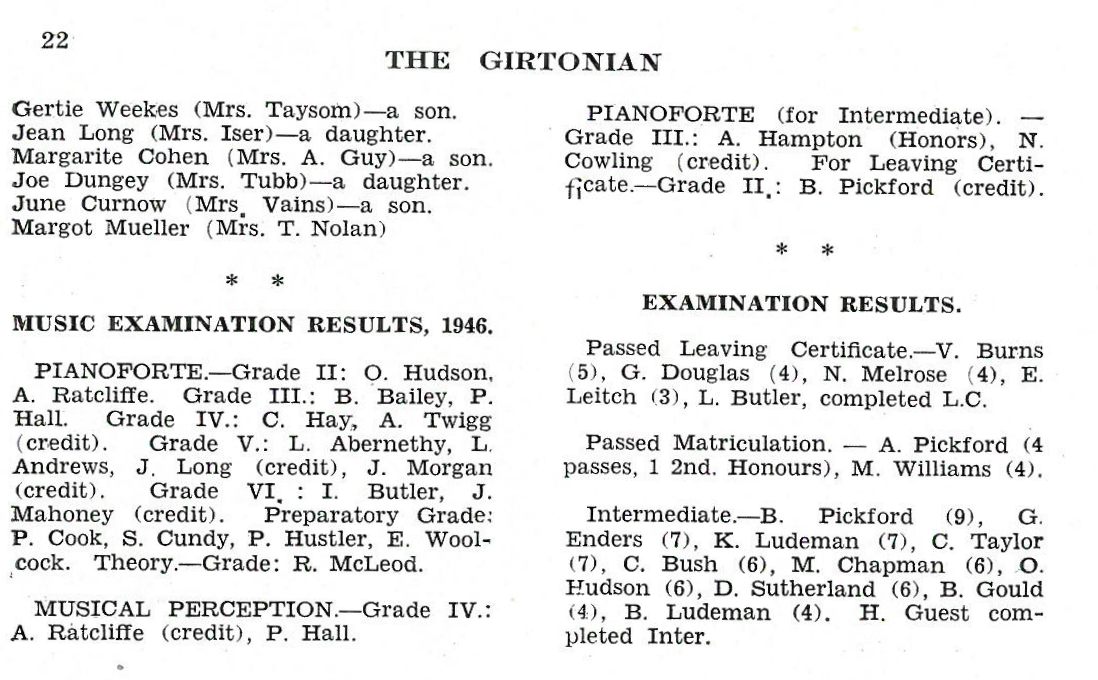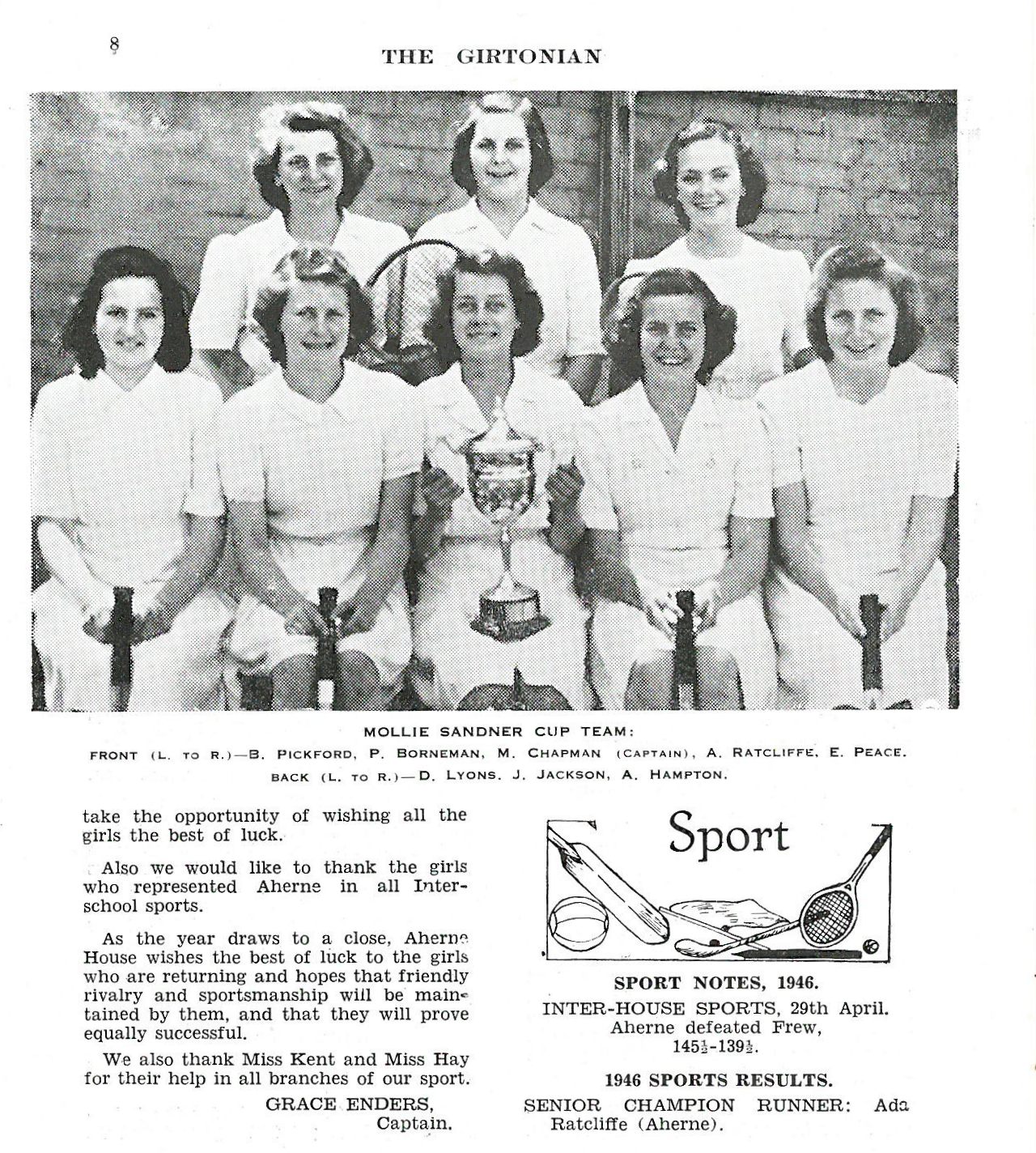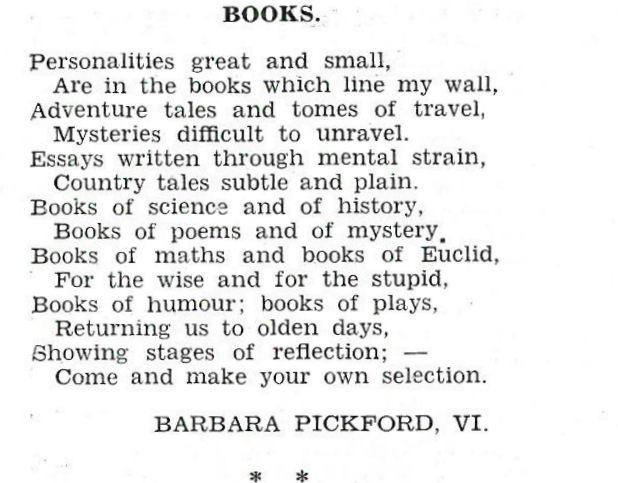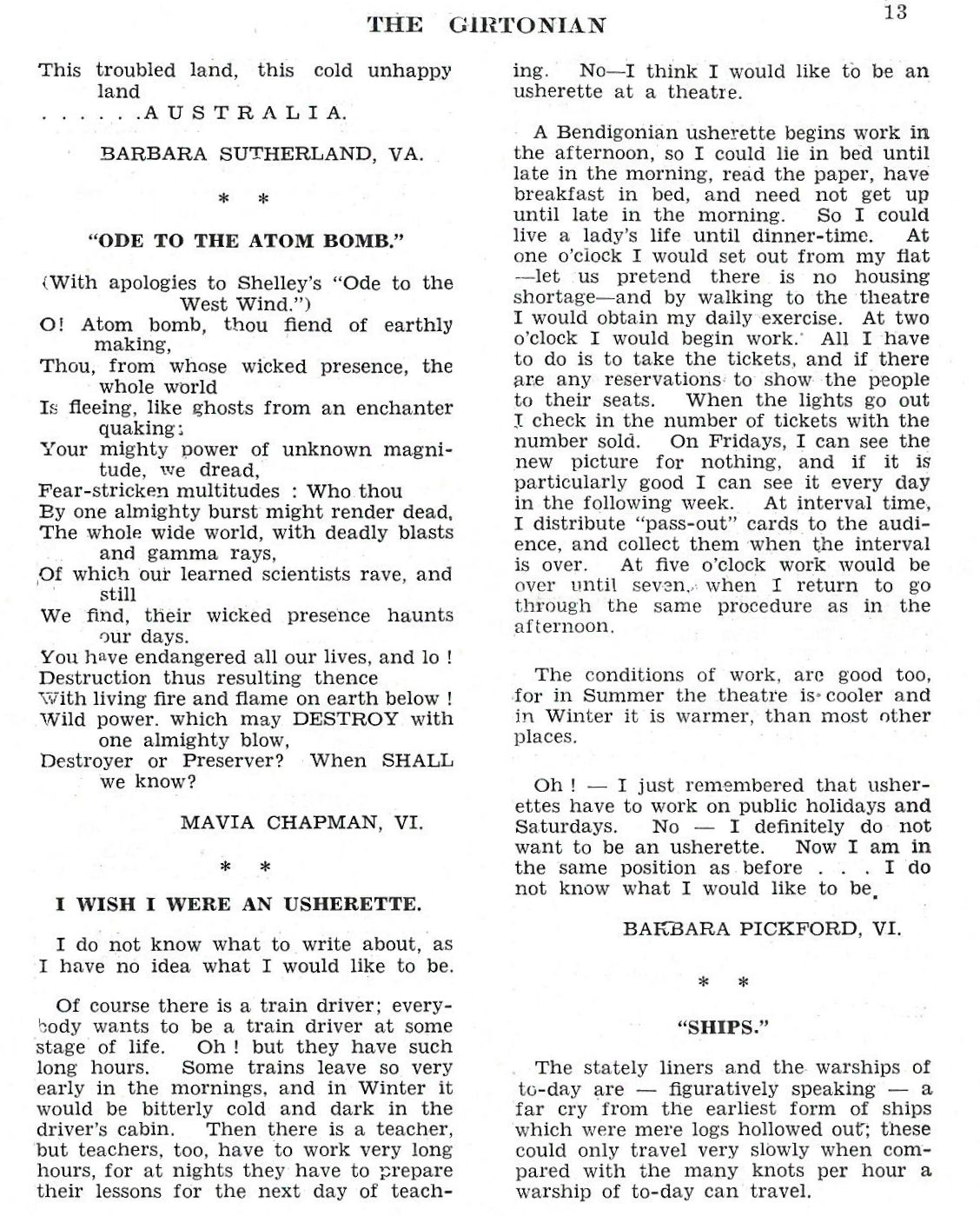The below article was submitted by Barbara Everist (nee Pickford) who was School Captain in 1947.
It contains precious memories of her time at Girton Church of England Girls Grammar School and rare detail about school in the 1930’s and 40’s in Australia.
Barbara currently has four grandchildren at Girton Grammar. Pictures are below:
I attended Girton from 1936-1947 and my late sister, Alison, was a Girton student from 1934 -1945.
I am not certain how many students were at Girton (perhaps 115 to 130, at a guess) from kindergarten to matriculation. Classes were small and occasionally there was more than one class in a room. Year 10 (4th Form) Intermediate Certificate level was considered a large class (12 or more). The Leaving and Leaving Honours (matriculation) years shared the same classroom and students sat around two tables. In 1947 the following students sat for the Matriculations Certificate – Pat Borneman, Olivia Hindson and myself (Barbara Pickford).
Studies – In Year 12 (Form 6) we wrote numerous essays for History (British) and English and were left to research for ourselves with limited library facilities – a good introduction for tertiary study. The Intermediate Certificate year, equivalent to today’s fourth form, was a bigger class. Many girls left school after Year 10. An Intermediate Certificate was the required standard for Nursing or Business Careers. No Science or Mathematics subjects were taught at Girton after Year 10, which limited career possibilities. I can recall that Diana Sutherland went to the High School after her Intermediate year at Girton in order to study the pre-requisite subjects for medicine at Melbourne University.
After matriculating at Girton in 1947, I spent a year at Bendigo High School as I was too young to be accepted at Melbourne University and there was to be no class equivalent to Year 12 at Girton in 1948. I sat for matriculation again at Bendigo High School and in 1948 was fortunate to receive Honours in four of the five subjects I passed and went to Melbourne University the following year with a Scholarship.
I went into residence at Janet Clarke hall where my sister, Alison, was completing her Arts Degree and Diploma of Education. After further study in England (Bachelor of Education) she returned to Australia. Later in her teaching career with the Education Department she was Principal of various Melbourne Schools, including Canterbury Girls’ School in Mangarra Road, Canterbury, and Vermont High School. She was amongst the first female Principals to be appointed to a co-educational school in the State Education System. Her married name was Alison Gliddon.
Other Old Girtonians in residence at Janet Clarke Hall were Diane Drake, Lorna Wallis, my sister, Alison Pickford, Diana Sutherland and myself. At that time Janet Clarke Hall was still affiliated with Trinity College. Diana, Lorna and myself met our future husbands at this time – all Melbourne University Trinity College students (Diana Alley, Lorna Kurrle, and Barbara Everist).
Our Annual Sports Day was held at the Upper Reserve. The two houses Aherne (blue and gold) and School (later Frew House – red and blue) practised for many weeks beforehand at recess, lunch time and after school. There was friendly rivalry in ball games (tunnel, overhead and leader ball and cross ball – both for eight participants), relays (athletics, skipping and sack relay races) and as well as an egg and spoon race, potato race and an obstacle race (which included eating an apple dangling from a piece of string without handling it).
In the Molly Sandner Cup competition we competed against St Mary’s Convent. It was a tennis competition for girls (16 years and under). If I recall correctly it was two single matches and two doubles matches. Girton won the Cup in 1946 and I am sure on some other occasions. Mrs Sandner, the wife of Dr Eugene Sandner always presented the Cup to the winning team. She was a charming lady not known for her punctuality. Her daughters, Lily and Julie, were students at Girton.
Dr Kerr, father of Lesley Kerr, who was in my sisters year at Girton, at one stage coached us in cricket on a very rough plot of ground on the other side of High Street. Basketball was very popular. We played against the High School girls and St Mary’s College girls.
During the war I can recall travelling to Macedon to run in an interschool relay at Clyde Girls School. Clyde was later combined with the Hermitage and both schools were amalgamated into Geelong Grammar when it became co-educational.
Music Events – Miss Batterham played the piano and Miss Webster conducted the choir. They were a successful pair, both taught students outside the school. We always enjoyed singing at Speech Night and other occasions. At one stage we produced the Gilbert and Sullivan Operas “The Mikado” and “Patience”. Girls took the male and female roles. Muriel Friswell, a Girton student with a beautiful voice, played the role of Patience.
There was a Ballroom Dancing Class after school at one stage. A very formal, straight foreign gentleman in a grey suit took the class after school hours in the Assembly Hall. There is a photograph on page 135 of the School History. His name was possibly Mr Slaweksi (or something similar). Girls took both female and male roles, (no young men were involved) consequently those who played the male role had difficulty with ballroom dancing in a later life. The temptation to lead, I discovered, never leaves one.
Speech Nights were special. We wore white dresses, the staff who had academic gowns wore them and the Bishop of Bendigo presided. In my time Bishop Baker and then Bishop Riley were Chairmen. I think at some stage, one or both of my parents, Canon and Mrs Pickford, were on the Council. There was always a Guest Speaker at Speech Night who gave out the prizes. There were Form Prizes, a Rhodes Prize, an Essay and Poetry Prize (the latter given by Dr Goodman), a Divinity Prize and Sports Cups. Even in the war years the prizes were embellished with the Girton Badge in gold. In 1947 the Senior Rhodes Prize was “The Fortunes of Richard Mahony”. As Dux of the school I received a leather bound copy of Tennyson’s poetry. I still have my prizes and value them.
The choir sang at Speech Night. I have good and bad memories of the school play. I recall being Robin Hood in green tights and in spite of many practices with a bow and arrow shooting it into the wings off stage at rehearsals, on the night of the performance the arrow I fired fell at my feet. In retrospect a serious production became a comedy and was possibly more enjoyable.
The War Years 1939 – 1945 Girton students were very aware of the war. On the home front foods such as butter, tea, sugar and meat were rationed and needed coupons to be purchased. Boarders would have been aware of this.
Students came to Girton to be away from Melbourne which could be bombed or invaded by the Japanese. Robin Potter was one of these students as was my cousin, Patricia, who attended Girton for a short period.
Our war effort as students included knitting camouflage nets, which we did sitting in a large circle at recess or lunch time. We also knitted large scarves and balaclavas in khaki coloured wool and bed socks without turned heels. Knitting socks was considered too difficult for young people to accomplish as amateur crafting of the toes and turning the heel could be uncomfortable for marching feet.
Air raid practice took place. A large trench (a shelter of sorts) was dug in the playground near the Myrtle Street entrance. Each student had a small packet of emergency rations, including a chocolate bar. Chocolate was highly treasured in the war years. I can recall a few practices when we abandoned our classrooms hastily for the shelter, taking our rations with us.
It was during the war years, which year I cannot remember, that there was a polio epidemic. Lessons were mailed to us at home and the school closed probably for a whole term.
There were also special Days of Prayer (Sundays) during the war. Crowds attended. I am sure the Boarders in their school uniforms would have marched in their crocodile formation to All Saints.
Staff would be difficult to find during the war years. I can recall one teacher, a Mrs Rado, I believe, whose husband was rumoured to be interned at Tatura. She taught French, I think. She lived in the Boarding House and could visit her detained husband at weekends. He later become very well known in Melbourne’s cultural circles.
It was customary for people recently arrived from Germany or Europe to be interned during the war. There was also a Mrs Young who made English come alive with her deep, expressive voice. Both were colourful, cultured ladies who taught at Girton during the war years.
Staff and Lessons – Naughty behaviour was usually punished with detention which was staying behind after school and doing extra lessons.
Certain classes were opportunities for a little frivolity such as Miss O’Keefe’s Speech Training Class. I can recall repeating numerous times in an exaggerated fashion:
“Henry Hall hope on his heels
What an odd habit
How horrid it feels.”
The temptation was to drop all the “aitches”.
Mrs Barnes, who spoke very rapidly, taught Intermediate Geography (Year 10) and possibly Civics. We followed “Janes Intermediate Geography” textbook to the letter and took pages of dictated notes. Her husband taught Chemistry at the High School. Mathematics (Algebra and Geometry) was not taught after Intermediate or Year 10 level. General Science, as it was named, was the final year of Science taught at Girton, also Year 10 level.
So subjects available for Leaving and Matriculation (Year 11 and 12) were English, Expression, English Literature, British History, French and Geography. Economics was introduced at one stage for matriculation. I recall being given a textbook “Supply and Demand” to read. It was a case of the blind leading the blind.
Latin was taught for a short time. The text books used were “Latin for Today” Parts I and II. I think that was taught in Years 8 and 9. French was the language taught in the Intermediate and Leaving years (equivalent to Year 10 and 11). To pass French I recall being coached by Mrs Alexander outside the school. She taught French at the High School. A language was a pre-requisite for an Art Course at Melbourne University.
Miss Warren, the Headmistress, and Miss Enid Mason were good friends. Miss Mason taught English to the senior classes.
The Boarders and day girls mixed well. Every term there were special days (Saturdays) when day girls could ask boarders home for the day. Girls also came to Girton to board because the Bendigo climate was supposedly good for asthmatics.
Assembly was held every morning. Students who played the piano accompanied the hymns. “Thou Whose Almighty Word” was popular. It was easy to accompany as the music score only had F#. Only the very accomplished could play “Jerusalem” on the piano.
This was followed by a Bible Reading by one of the Prefects or Probationers and then a prayer spoken by the Headmistress and finally any notices for the day.
My father taught Religious Instruction at Girton for some time, which I found rather embarrassing. It was hard to keep attention levels in Scripture classes. There was an Exam for Scripture which I always felt I had to do well in. My mother was also involved. She may have been on the School Council. She was one of the Committee either appointed by Bishop Riley or the School Council to select the Headmistress. She grew up in Kew, Melbourne and later moved to Geelong. She was one of four girls. She attended M.L.C. and then The Hermitage in Geelong. Her oldest sister, Hilda Ball, was the Headmistress at Tintern at a young age. Another sister, Daisy, taught music and looked after the Boarders at M.L.C. Mother was always interested in education for girls.
Haphazard Memories
No longer is the haunting smell of tomato sauce coming from the building on the Vine Street corner. It was against the wall of the old factory where we left our bicycles. Alison and I rode to school from the Rectory of St Pauls’ in Myers Street, where my father was vicar from 1934 to 1959. We rode along Wills Street and down Myrtle Street. I rode on my Malvern Star on the inside of my older sister, Alison. At the foot of the Myrtle Street hill we frequently met Lorna Wallis (from Olinda Street) and rode as a trio. On very wet days we trammed, changing trams at the Fountain. We rode on our bicycles home for lunch, gulping down lunch quickly, returning for tennis, basketball or sports practices before afternoon lessons.
The Monkey Puzzle tree is still there outside the old Administration Building and nasty girls that we were, we waved prickly branches at calf and knee level above our socks – a painful experience.
I remember too the Chapel style building on page 148 of the School History. It reminds me of freezing cold winters. From classes there we were sent regularly to run down to the Myrtle Street entrance and back to warm up between lessons. There was little or no heating.
My impression of the school today
I have now attended several Family Days at Girton and have so much enjoyed being shown around the school by Georgia, Harry, William and Emily. I can appreciate the wonderful changes that have taken place. The skeleton of some of the old buildings remain – the Headmistress’ Office, the old Staff Room, the long connecting passage in the original Victorian house and the Boarders’ quarters, the old kitchen with the brick walkway adjoining the old Science Room with its Bunsen Burners and little else. I remember also when the next door house was purchased in Myrtle Street and became Frew House.
On my recent visit to Girton (Sept 2016) which included the morning at Emily’s Junior School and an afternoon visit to William’s Aherne House Concert in the Senior School, I was amazed at the size and extent of the school itself and its facilities. But without doubt what impressed me most was the “soul” of the school – the happy relationship between staff and students and the friendliness and warmth that greet you. It has been amazing 122 years.
A Brief History (Personal)
After completing my Bachelor of Arts at Melbourne University, majoring in International Relations and History, I worked at a publishing company (Wilkes) and then as Secretary to the Academic Secretary at Melbourne University while my husband-to-be, Ian Everist, was studying on a Rotary Scholarship at the Hydraulics Laboratory at Minnesota University.
On his return we married in February 1954 and went immediately to live in Burnie, Tasmania, where Ian had been commissioned by his firm, Garlick and Stewart (Consulting Engineers and Surveyors) to give Burnie a new water supply by constructing the Pett River Dam System.
This task was completed in 1959. We returned to Melbourne with two Tasmanian children, Peter and Anne.
While resident in Burnie, I taught for a short time at the Burnie High School (Year 10 level) – History and Geography and surprisingly Mathematics, which required some help from my husband’s mathematical talents.
We returned to Victoria to live in Canterbury, Melbourne for forty years. Philip and James were the Victorian additions to our family. The three boys attended Camberwell Grammar for all their schooling and Anne attended Korowa Girls Grammar School.
James and Cassandra and their four children have now settled in Bendigo after several years in Singapore and it is with great interest I follow their schooling at my old school.
While the boys were attending Camberwell Grammar School I was involved in the Library there, keeping the Vertical File on current affairs and in 1980’s assisting Dr Ian Hansen with the research for the Camberwell Grammar Centennial History published in 1986. This involved interviewing “Old Boys” and numerous expeditions to the Public Library.
My husband, Ian, became Senior Partner and Chairman of Fisher Stewart (originally Garlick and Stewart, Consulting Engineers and Surveyors) and my chief interests in my latter life have been family (now with twelve grandchildren) and supporting my late husband’s activities in his work and in the community for which he received an O.A.M.
We retired to Flinders, Victoria, in the early 90’s and it is where I continue to live a happy and full life.
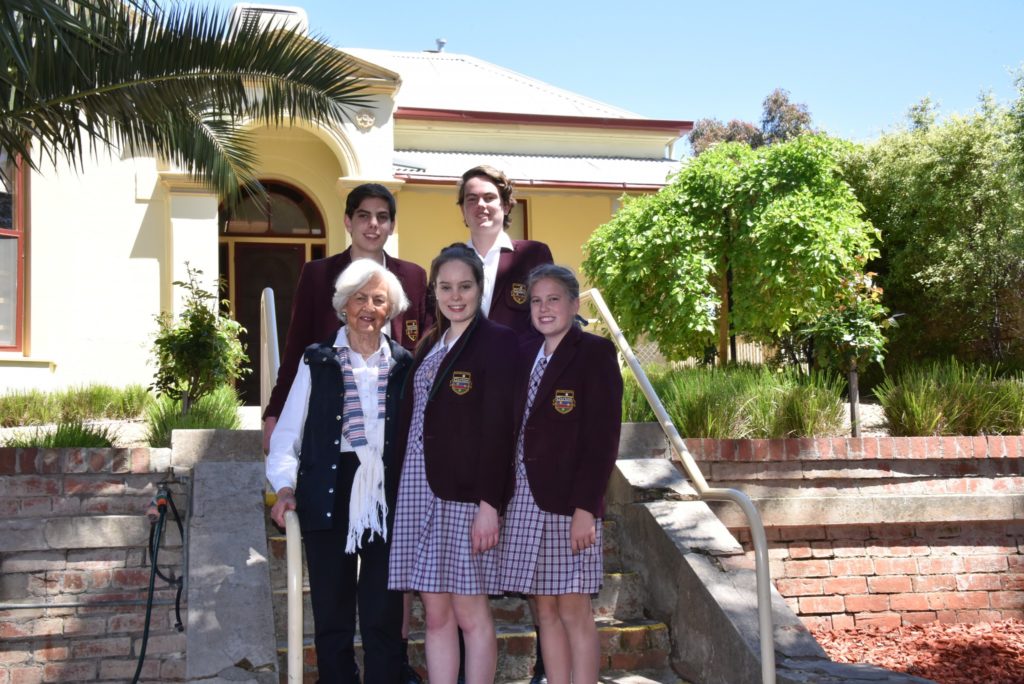
Barbara with her Grand-daughters, Georgia (left) and Emily and Grandsons Wil (left) and Harrison
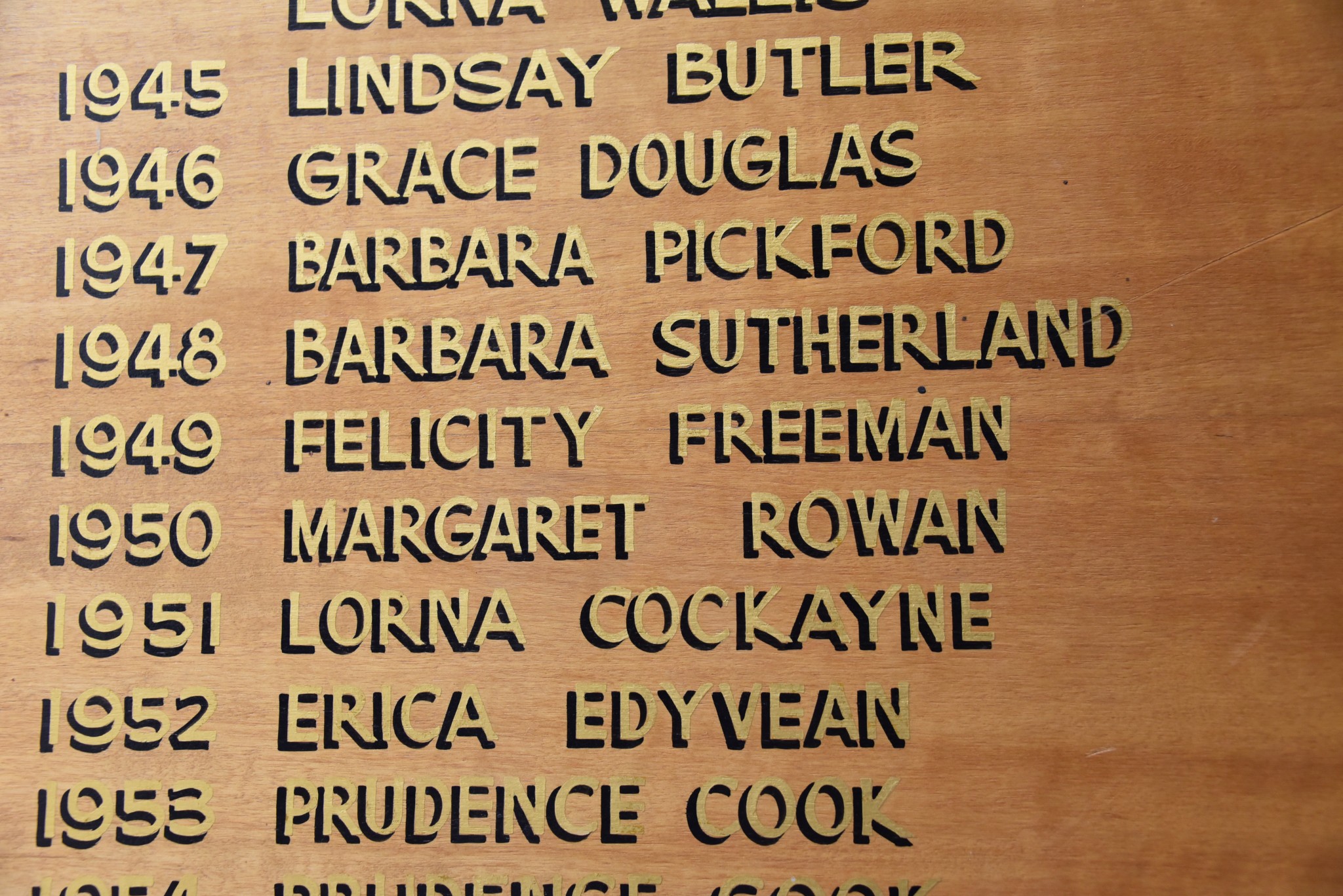
The Honour Board with Barbara’s name on it now hangs in Girton House in Junior School
The below pages are from the 1946 Girtonian Magazine and feature articles about or by Barbara:
